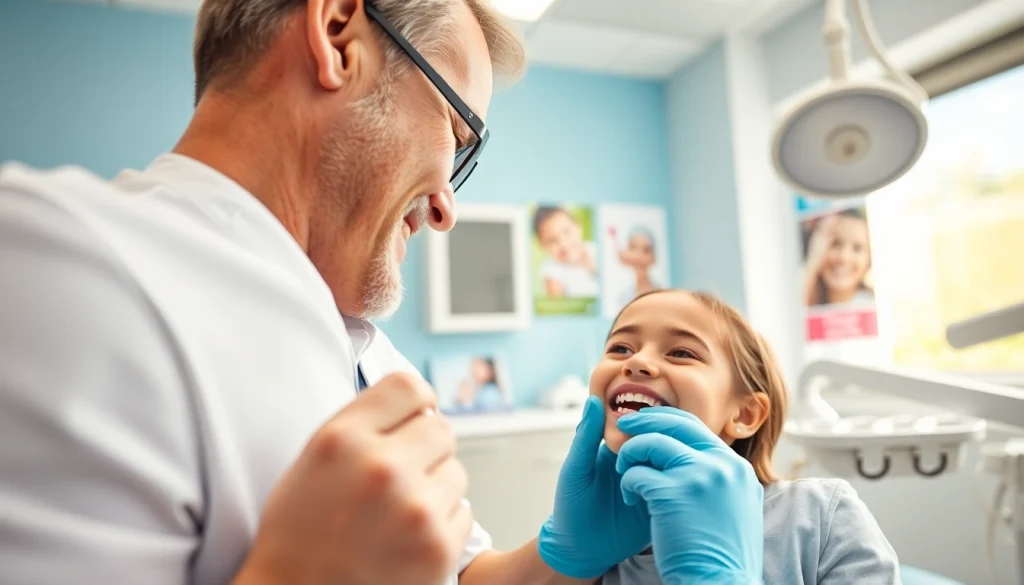Comprehensive Care with Your Orthodontist Myrtle Beach for a Healthier Smile

Understanding Orthodontic Services in Myrtle Beach
Orthodontics is a specialized field of dentistry focused on diagnosing, preventing, and treating facial and dental irregularities. It is a crucial service for individuals seeking to improve their oral health, aesthetic appeal, and overall confidence. In Myrtle Beach, patients have access to various orthodontic services that cater to different needs and age groups. Engaging with an orthodontist Myrtle Beach ensures that patients receive personalized care tailored to their specific requirements.
Types of Orthodontic Treatments Available
Today’s orthodontic treatments are varied and customizable, enabling patients to select options that best match their lifestyles and dental health objectives. Below, we explore some of the main treatments available.
- Metal Braces: The most common type of braces made of high-grade stainless steel. Metal braces consist of metal brackets and wires that align teeth over time.
- Ceramic Braces: Similar to metal braces, but the brackets are made from clear or tooth-colored ceramics, making them less visible.
- Lingual Braces: These braces are positioned behind the teeth, making them invisible from the outside.
- Invisalign: A revolutionary treatment that involves a series of custom-made, clear plastic aligners that gradually shift teeth into place without the need for traditional braces.
- Palatal Expanders: Devices used to widen the upper jaw to create more space for the teeth or correct dental bite issues.
- Retainers: After braces or clear aligners, retainers are essential for maintaining teeth in their new positions.
Who Can Benefit from Orthodontic Care?
Orthodontic services benefit a wide range of individuals. While traditionally considered a treatment for children and teenagers, adults can also greatly benefit from orthodontic care. Here are some of the groups that can be positively impacted:
- Children: Early intervention can prevent more severe orthodontic issues later in life. Typically, kids aged 7 to 12 years may need assessment for potential orthodontic issues.
- Teenagers: The adolescent phase is common for braces treatment as permanent teeth are fully developed and emerging.
- Adults: Increasingly, adults are seeking orthodontic correction to improve oral health and aesthetics.
Common Myths about Orthodontics Debunked
There are several misconceptions about orthodontics that can deter people from seeking necessary treatment. Here, we will debunk some of the most prevalent myths:
- Myth 1: Orthodontic treatment is only for kids and teens. Fact: Adults can also benefit significantly from orthodontic care.
- Myth 2: I can wait until my teeth are more crooked before seeing an orthodontist. Fact: Early intervention often leads to simpler and less costly treatment.
- Myth 3: Braces are painful and uncomfortable. Fact: While discomfort can occur, advances in technology have made braces more comfortable than ever.
Choosing the Right Orthodontist Myrtle Beach
Selecting the right orthodontist is crucial for successful treatment. The right professional will ensure that your experience is comfortable and that you achieve the results you desire. Here’s how to navigate the selection process.
Factors to Consider When Selecting an Orthodontist
When searching for an orthodontist, consider the following factors:
- Qualifications: Look for an orthodontist who is board-certified and has excellent credentials.
- Experience: A practitioner with extensive experience in various treatments is usually better equipped to handle complex cases.
- Treatment Options: Consider whether the practice offers various treatment methods, including traditional braces and Invisalign.
- Technology: An orthodontist who uses the latest technology can often provide higher-quality care and more efficient treatments.
- Patient Reviews: Research reviews and testimonials from previous patients to gauge others’ experiences.
What to Expect During Your First Consultation
Your first visit to an orthodontist typically involves an evaluation and set of x-rays to determine the alignment of your teeth and jaw. Be prepared for the following:
- A discussion of your dental history and any concerns you may have.
- A comprehensive examination of your teeth, bite, and jaw position.
- Recommendations for treatment options tailored to your specific dental alignment needs.
- A review of potential timelines and costs associated with the recommended treatments.
Checklists for Evaluating Orthodontic Practices
Utilizing a checklist can streamline your decision-making process when evaluating orthodontic practices. Here’s a helpful framework:
- Check the orthodontist’s credentials and memberships in professional organizations.
- Inquire about the technologies and techniques used in the practice.
- Assess the orthodontist’s communication style and willingness to answer questions.
- Evaluate the office environment for cleanliness, friendliness, and organization.
- Ask about financing options and insurance coverage.
Braces vs. Invisalign: Making the Right Choice
The decision between braces and Invisalign can significantly impact your orthodontic journey. Both options have unique benefits and drawbacks that cater to different patients’ needs.
Pros and Cons of Traditional Braces
Traditional metal braces have been a popular orthodontic solution for years. Here are some pros and cons:
- Pros:
- Effective for complex cases.
- Not removable, ensuring that they must be worn as prescribed.
- Cons:
- More visible than clear aligners.
- Discomfort from brackets and wires.
- Dietary restrictions to avoid damaging the braces.
Invisalign: The Modern Approach to Straightening Teeth
Invisalign aligners offer a discreet alternative to traditional braces. Here are the advantages and disadvantages:
- Pros:
- Clear aligners are nearly invisible.
- Removable, allowing patients to eat and brush without restrictions.
- Cons:
- May not be suitable for severe orthodontic issues.
- Requires high patient compliance to wear the aligners for the recommended time.
Cost Comparison and Insurance Considerations
The cost of orthodontic treatments can vary significantly. Generally, traditional braces tend to be less expensive than Invisalign. Patients should always inquire about the following:
- General treatment costs for both options.
- Payment plans available through the orthodontist’s practice.
- Insurance benefits covering braces or aligners.
Maintaining Oral Health During Orthodontic Treatment
Maintaining good oral hygiene during orthodontic treatment is crucial for preventing cavities and gum disease. Here are key considerations for patients undergoing orthodontic care.
Daily Care Tips for Braces and Aligners
Here are some vital daily care tips:
- Brush your teeth at least twice daily with a fluoride toothpaste.
- Floss regularly using a floss threader or orthodontic floss to clean between brackets and wires.
- Utilize interdental brushes to keep areas around braces clean.
- Rinse with an antibacterial mouthwash to reduce plaque buildup.
Foods to Avoid While Wearing Braces
Certain foods can damage braces or make them less effective. It’s best to avoid:
- Hard foods such as nuts, ice, and hard candy.
- Sticky foods like caramel and chewing gum.
- Crunchy foods such as popcorn and raw carrots.
Regular Check-Ups: What to Expect
Regular visits to your orthodontist are essential for monitoring treatment progress and making necessary adjustments. During these appointments:
- The orthodontist will check the placement of brackets and wires.
- Necessary adjustments will be made to ensure optimal progress.
- Any concerns or questions regarding treatment can be addressed.
Success Stories: Transformations Achieved through Orthodontics
Orthodontics has enabled countless patients to achieve stunning transformations and improve their quality of life. Here are elements of those success stories.
Patient Testimonials on Their Experiences
Many patients report significant improvements in their self-confidence after completing their orthodontic treatment. Positive experiences often highlight:
- Improved aesthetics contributing to enhanced social interactions.
- Better oral health resulting from properly aligned teeth.
Before and After: Visual Evidence of Change
Many practices showcase before-and-after images of their patients to demonstrate treatment success. This visual evidence serves as motivation for potential patients considering orthodontic care.
The Emotional Benefits of a Confident Smile
Beyond the physical changes, the emotional impact of achieving a beautiful smile can be profound. Patients frequently express:
- Increased self-esteem and confidence in personal and professional settings.
- A greater willingness to engage socially without feeling self-conscious about their teeth.
To conclude, undergoing orthodontic treatment can dramatically enhance both health and well-being. By choosing an expert orthodontist Myrtle Beach who understands your individual needs, you’ll be on your way to a healthier, straighter smile that lasts a lifetime. Remember, investing in your smile is also an investment in yourself!







